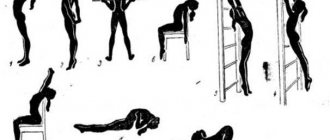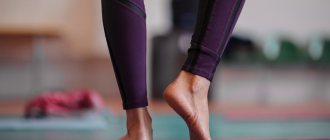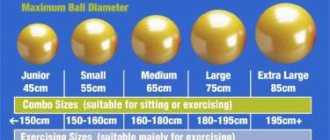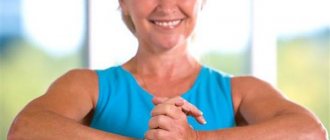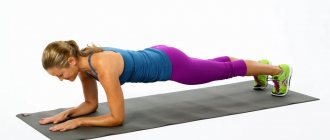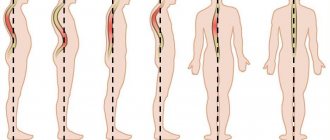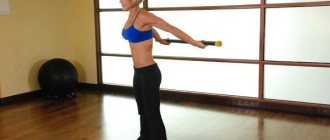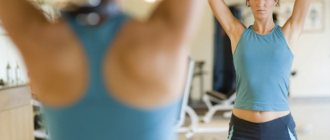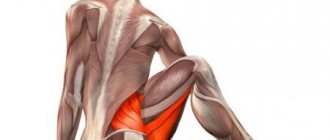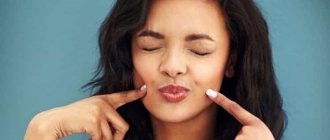Cosmo recommends
Anti-trends for spring 2020: which boots are no longer in fashion (beware, bad taste!)
Coloring went wrong: how to fix a bad hair shade
Stretching can be used not only as a warm-up and cool-down, but also as an independent workout. If you want to get rid of tightness in your muscles, become more flexible and flexible, and relieve tension from your spine, we recommend that you do daily body stretching at home.
Benefits of regular stretching:
- improves posture, relaxes back muscles;
- increases flexibility of muscles and joints;
- accelerates blood circulation, stimulates metabolism;
- reduces the risk of injury;
- increases muscle endurance;
- calms, relieves stress and fatigue.
Contraindications to stretching:
Forward bend exercise against stress and poor stretching
- recent injuries;
- joint diseases;
- hernias;
- severe curvature of the spine;
- vascular diseases;
- osteochondrosis.
If the goal is weight loss
If you want to not only work out your muscles, but also lose weight, be sure to add several hours of aerobics per week to your strength training. This way, you will achieve impressive results faster. Your waist will decrease in volume, and your stomach will noticeably tighten.
In the future, to maintain the results achieved, you will need to train several times a week, and consider proper nutrition not as a temporary measure, but as your way of life.
How to do stretching at home
To stretch effectively and safely, beginners need to follow some rules.
- Do not stretch after the onset of pain. If you feel pain, stop in the achieved position and concentrate on relaxation.
- It is recommended to stretch at home after warming up the muscles.
- Maintain an even rhythm of breathing while stretching.
- Avoid jerking and other sudden movements. Stretching should be smooth and gradual.
Stretching exercises for beginners at home
As before any other workout, a warm-up is also required before stretching. First, do a simple cardio routine to warm up your muscles and make them more pliable. Then take a mat and start stretching. We have prepared exercises for the back, arms, legs and split stretches at home.
Head tilts
This type of stretching for the neck muscles serves as an excellent prevention of cervical osteochondrosis.
- Tilt your head towards your right shoulder, holding it with the same hand.
- Try to relax your neck muscles as much as possible.
- Switch sides.
Shoulder stretch
Allows you to stretch your biceps, relieving tension from them, and also tones your arms. Increases the flexibility of the shoulder joints.
- Grasp your right hand with your left above the elbow, press it to the body.
- Straighten your arm, lowering your right shoulder.
- Stretch your hand to the left. Then repeat with the other hand to the left.
Triceps stretch
Helps stretch the triceps and the front of the shoulders.
- Place your right hand behind your back on top and your left hand below.
- Point the elbow of your upper hand toward the ceiling, and the elbow of your lower hand toward the floor.
- Strive to connect your fingers behind your back. If this comes easy to you, clasp your palms together.
"Cat"
This exercise stretches the back muscles and increases the flexibility of the spine.
- Get on all fours.
- Round your back as much as possible, lowering your head.
- Then gently arch your back, bringing your shoulder blades together.
Child's pose
This comfortable, relaxing pose is very beneficial for a tired back.
- Sit on the floor on your knees.
- Lean forward, placing your stomach on your knees.
- Straighten your arms in front of you and reach for them.
Downward Facing Dog Pose
A yoga pose helps stretch almost the entire body - from the shoulders to the feet.
- From a standing position, lean forward and take steps on your hands.
- Continue walking until your body forms a right angle.
- The back should be straight and the heels should be towards the floor.
Side stretch
Uses those muscles that practically do not work in everyday life. Promotes a slim waist.
- Stand up straight, raise your arms up.
- Interlace your fingers together, palms facing the ceiling.
- Stretch up and lean to the right. Repeat on the other side.
Lying crunch
Increases the flexibility of the spine, perfectly relieves tension in the lumbosacral region.
- Lie on the floor, place your arms at right angles to your body.
- Raise your right bent leg and place it behind your left. Aim to place your knee on the floor.
- While twisting, try to relax as much as possible.
Forward fold
An excellent exercise for stretching the splits at home.
- Sit on the floor, spread your straight legs to the sides.
- Lean forward, breathe deeply, trying to relax your muscles.
- Stretch forward, trying to put your stomach on the floor.
Stretch against the wall
This exercise perfectly stretches the muscles of the inner thighs.
- Lie on the floor against a wall, perpendicular to it.
- Spread your legs. They will fall under their own weight.
- Relax and lie in this position for several minutes.
"Frog"
This is one of the best split stretching exercises for beginners.
- Lie on your stomach, spread your bent legs to the sides.
- Maintain a straight angle at your knees.
- Stretch your pelvis towards the floor.
Deep Lunge
Helps stretch both the back and front of the thigh. Tightens muscles, improving the relief of the hips.
- Lunge forward, placing your hands on either side of your front leg.
- Place your back knee and palms on the floor.
- Reach down, feeling the stretch in your thigh muscles. Switch legs.
If you want to make your silhouette slimmer, you will need tips on how to reduce your hips and buttocks at home.
"Fold" for stretching
This exercise is performed not only to develop the abdominal muscles. It is leading to the longitudinal twine. Therefore, the “Fold” stretching exercise is used by gymnasts, yogis and other training people.
Its goal is to develop the hamstrings. However, in addition to it, the muscles of the back and buttocks also work.
Initial position: sitting on the floor. Legs extended in front of you. Knees point up. The feet are pressed against each other. Straight back and relaxed shoulders.
Sequence of actions when performing the exercise:
- First of all, you need to straighten your back. From the starting position, try to stretch the top of your head as high as possible. In this case, the chest and lower back bend slightly forward. Gently, on your hands, rise up. Try to point your heels forward and your tailbone up.
- Bend over slowly, but never lie down completely. Bend over so that your stomach rests on your thighs, without lowering your chest. Arch your hips. Place your stomach from its lowest point. Stay in this position for a few seconds. Let your body get used to it. Hands should be on your knees. However, you should not strain them and try to pull yourself down.
Undoubtedly, everyone now wants to reach their chest to their knees, clasp their feet with their hands and congratulate themselves on a small victory. And, as you already guessed, this is not worth doing. Because this is how another exercise is performed - to round the back. It is also useful, but at the moment our goal is to stretch the hamstrings.
For the Fold, the tilt is accomplished by lengthening the spine rather than rounding. The goal is to place your chest behind your knees, not on them. That is, you need to stretch forward. Over time, everyone succeeds. There is a joke of sorts: you can't put your chest down until you have the chance to bite your big toe. You need to try to stretch as you exhale. The maximum number of repetitions is 10. On the last exhalation, stretch as far as you can forward, and then slowly come out of the position.
You should try to do several types of “Folds” in one workout.
Exercise options
Depending on the level of training, a person performs the exercise options available to him. To do this, there are several types of “Folds” difficulty:
- Dynamic. This type perfectly warms up the muscles. Take your starting position. Stretch your head up. Raise your hands and then place them on your hips. Now make gradual bends, lowering your stomach to your feet. To start, do slight inclines. Gradually going deeper and not rising to the starting position. Do about thirty times to warm up your muscles.
- Reverse. The initial position is: the body resting tightly on the hips. The legs are bent. Hold your feet with your hands. Now gradually straighten your legs. Do this slowly so you can get used to the new position. This “Fold” does not strain the muscles so much.
- Socks from myself. It is better to start the “Fold” exercise and get to know it with this option. Since with the toes extended away from you, there is less load on the popliteal fossae. That is why this option is easier for beginners.
- Socks on yourself. Accordingly, this option is more complex. Since now the popliteal fossae are already included. They tell us about this with nagging pain. The main difference from the previous version of the exercise is that your toes should be directed towards you.
- With weight. Here you will need the help of another person. This option assumes that we will be pulled with the help of a partner.
- With support. A more complicated option for those whose body fits perfectly on their feet. Gymnastic cubes or rollers are placed under the heels. And your partner gently presses on your back. This option will allow you to stretch your knees perfectly.
Common Mistakes
When performing exercises, a person sometimes does not notice the result. This is due to incorrect execution technique. The most common mistakes include:
- neck pressed into shoulders;
- back “wheel”;
- knees turned outward;
- improper breathing;
- an overly tense state;
- incorrect placement of the feet;
- legs bent at the knees.
All these moments should be controlled, since the result is built from such little things. The more mistakes made, the less effective the training.
Exercise “Fold”: technique of execution
This element of training is a great way to develop muscles. The “Fold” exercise is used for abs and stretching. The execution algorithm depends on the goal. After all, all abdominal exercises focus on losing weight.
It is important to follow the sequence:
- Lie down on the floor. Press your back tightly against him. Stretch your arms up behind your head. They should be straight, as should the legs. Be sure to press your lower back to the floor.
- Take a breath.
- As you exhale, lift your straight legs and body at the same time. Try to keep your palms touching your toes.
- Stay in this position for a couple of seconds.
- As you inhale, carefully take the starting position. But do not lower your legs and arms completely; your back should remain rounded and your abs in a state of tension.
- Repeat the exercise several times.
Lead-up exercises
Beginners do not always manage to immediately perform the fold correctly. If you feel discomfort in the lower back or extreme fatigue after the first repetitions, you should prepare your muscles with the help of building exercises:
- Lie on the floor and stretch your legs straight up. Exhale and twist forward, trying to touch your palms to your feet.
- Do the fold not with both legs at once, but with each leg in turn.
- Raise your legs with your knees bent. This will make the movement much easier.
Perform conditioning exercises for at least two weeks. Your muscles will become stronger and your body will become more flexible, which will eventually allow you to do a standard exercise.
A simplified version of the fold.
An exercise such as the fold allows you to effectively load all the abdominal muscles. The results will become noticeable after a few months of training. For best results, combine it with other abdominal exercises. These could be, for example, double crunches, oblique crunches, and lying leg raises. If you want to reduce your waist size, be sure to combine folding and twisting with proper nutrition and aerobic exercise.
Exercises for the abdominal muscles
Each part of the human body can be developed in several ways. Likewise, exercises for the abdominal muscles are varied.
The most common options offered by instructors in gyms look like this:
- Twisting.
- Lifting the body.
- Crunches on a bench.
- Plank.
- Diagonal leg lift.
Fun abdominal exercises
Constantly doing crunches to pump up muscles gets boring. Therefore, it is sometimes worth diluting them with other interesting exercises.
Abdominal workout:
- Rotates the body on the plank, leaning on the ball.
- Roller ab trainer.
- “Side plank” on a bolster.
- “Fold” with body rotation.
- "Simplified plank".
- Support on a ball or roller.
How to Increase Effective Exercise
Correct execution technique is the key to a successful result. It doesn't matter if these are exercises for girls or guys. It all depends on the execution technique. In the gym, a trainer may comment on you about incorrect execution. And when practicing at home, a regular video camera will come to your aid. Set it up at some distance and start doing the exercises. Then watch the video, did you do everything correctly?
Tips for increasing the effectiveness of classes:
- Breath. Be sure to control your exhalations.
- Exercise in comfortable clothes and shoes. Nothing should hinder your movements.
- Do not hurry. Even if the training takes longer, and you may not have time to complete some exercises, the ones you do manage to do will be of high quality.
- Monitor the load on your muscles yourself.
- Feel where and with what movement this or that muscle tenses.
Common Mistakes
When performing exercises, a person sometimes does not notice the result. This is due to incorrect execution technique. The most common mistakes include:
- neck pressed into shoulders;
- back “wheel”;
- knees turned outward;
- improper breathing;
- an overly tense state;
- incorrect placement of the feet;
- legs bent at the knees.
All these moments should be controlled, since the result is built from such little things. The more mistakes made, the less effective the training.
What muscles work in the fold exercise?
The tuck exercise uses all the abdominal muscles. If other movements are aimed at working a specific area, then this exercise is universal.
The main impact when performing the fold exercise falls on:
- Rectus abdominis muscle.
- Deep layers of the abdominal muscles (only with slow and concentrated execution).
- Oblique abdominal muscles (work minimally and stabilize the body).
The gluteal, thigh and pelvic muscles are also partially involved in the work, but their involvement is considered secondary.
It is important to consider that the fold on the press equally loads the lower and upper press. Despite the fact that it represents a single area - the rectus abdominis muscle, all nerve endings work in this movement (both from the lower and upper parts). This makes the movement one of the most useful for working out the entire muscle group.
Muscle load
Of course, when performing a fold, the entire rectus abdominis muscle (both lower and upper parts) actively works. Therefore, performing a fold can replace traditional crunches, which mainly load the upper abdominal areas, and lying leg raises (or reverse crunches), which shift the load to the lower abdomen.
In addition, the exercise loads the oblique abdominal muscles, which in any case will work simultaneously with the rectus abdominis muscle. At the same time, the load on them in this exercise will not be as intense as, for example, with the addition of torso rotations in lateral twists.
According to the residual principle, the hip flexors and quadriceps muscles of the thighs (quadriceps) are included in the work.
In order to not only effectively pump up muscles, but also to reduce excess weight, it is necessary to add cardio (aerobic) exercise to strength training. This will speed up the delivery of excellent results. The waist circumference will decrease, the stomach will become flat and toned.
In order to maintain the results you have achieved in the future, you need to continue a healthy lifestyle, which includes physical activity (at least 3 hours a week) and a proper balanced diet.
Pros and cons of the fold exercise
The main benefits of the abdominal tuck exercise:
- Works the entire abdominal area.
- It has several different execution techniques and difficulty options for athletes with different levels of training.
- Can be performed anywhere and does not require additional equipment.
- Prevents the appearance of inguinal and umbilical hernias.
- Normalizes posture by increasing the tone of the core muscles.
There are only two disadvantages - the complexity of execution (applies to some options) and the requirement to perfectly follow the technique. Without mastering it, the efficiency of movement will significantly decrease.
Muscle load
The fold intensively works all the abdominal muscles, especially the rectus abdominis (its lower and upper parts). Thus, this one exercise replaces classic crunches, which load the upper abs, and lying leg raises (or reverse crunches), which emphasize the load on the lower abdominal muscles.
The exercise also uses the oblique abdominal muscles - they always work in conjunction with the rectus abdominis. However, the load on the oblique muscles in this exercise will not be as significant as, say, in oblique or lateral crunches.
The hip flexors and quadriceps (quadriceps) work in an additive manner.
Technique of abdominal fold exercise lying on the floor
There are many ways to make a fold. Even the “book” exercise actually refers to the same type of movements, although it is performed in a sitting position.
For the press, a fold on the floor is considered a classic option. Technique:
- Lie down on the floor. Feet together, arms brought together and extended above the head.
- Begin to slowly raise your legs, trying to lift them as high as possible (without bending them).
- Simultaneously with the movement of your legs, twist, lifting your shoulder blades off the floor. Bring your hands together and reach towards your toes.
- Take a minimal pause at the top point and return to the starting position without relaxing your abdominal muscles.
The closer you can bring your hands to your feet, that is, fold them, the greater the benefit will be. For beginners who find it difficult to perform the full version, it is recommended to limit themselves to partial amplitude (only if the technique is not violated), gradually moving on to the full execution of the movement.
How to make your abdominal workout more effective
Twisting with legs raised belongs to the category of lead-up exercises. This is a lighter version of the fold that will prepare the athlete to perform the basic version. While performing it, you need to keep your hands on the back of your head and your legs in weight. Then, smoothly bend your knees and pull them towards your chest, while simultaneously moving your body forward.
Crunches with raised legs are more suitable for those who cannot train at full strength due to insufficient development of motor coordination and balance. A simplified version of the book can be used to complete a workout on the abs - to finish off the main muscles that were worked on during the training.
The preparatory exercises include variations of the fold with stretches. They are close to the standard version of the book. Traditionally, stretching is performed at the very beginning of working on the abdominal muscles. It develops flexibility and allows you to gradually increase the complexity of the load. Lying stretches are done in this way:
- Lie on the mat, raise both legs in front of you and bend them slightly at the knees.
- Stretch both arms behind your head, while pressing your lower back to the mat, your hips should be at right angles to the surface.
- Without moving your legs, round your back, and then raise your arms, reaching your toes with your fingers.
- Return to the original position without jerking and repeat the movements without lowering your legs to the surface.
If you wish, while preparing for a more complicated version of the fold, you can do the exercise not with both legs at once, but with each leg in turn. To improve flexibility, it is advisable to complete each workout with a stretching block.
After mastering the preparatory exercises, and then the basic folding technique and its variations, you can complicate the training of the abdominal muscles. To do this, you should use various weights - for example, hold dumbbells or a barbell in your hands. Abdominal training with additional weight helps you get those coveted abs - of course, if the fat layer on your stomach is minimal.
It is necessary to take into account that the book does not load the oblique muscles so much. And if the goal is to strengthen them, then oblique crunches should definitely be included in your abdominal training. The fold goes well with leg raising exercises. For beginners, it is advisable to add three types of load on the target muscles to the complex, and for more experienced athletes - five or six.
Photos used from Shutterstock
You read a lot and we appreciate it!
Leave your email to always receive important information and services to maintain your health
Common mistakes
The most popular mistakes:
- Lack of concentration on the abdominal muscles - the load is “taken away” by other muscles, making the movement ineffective.
- Trying to get stronger by rounding your back - this option is more likely to lead to injury than to improving the load on the abs. Circulation should be minimal and anatomically correct (only when performed on the floor).
- No exhalation at the moment of bringing the legs and body together - correct exhalation is the key point. Without it it will be almost impossible to work out.
- Active movement of arms and legs - when performing, the arms and legs are motionless. The main movement is achieved through the abdominal muscles.
Varieties of exercise: on the floor and bench
It is advisable to do the fold on a non-rigid yoga mat or horizontal bench. The main variation of the exercise is a set of movements on the floor. To master it, you need to remember the technique step by step:
- Lie on the mat, stretch your arms above your head, press your lower back to the surface and straighten your legs.
- As you exhale, simultaneously lift your arms and legs from the surface, keeping them straight.
- Try to reach your toes with your palms while twisting the body.
- Hold at the final point and lower while inhaling to the starting position without jerking.
The back during movements should not remain straight, but rounded, so as not to injure it. All exercises similar to a fold must be done while constantly keeping the abs tense. Flexion should be carried out through the work of the abdominal muscles. The more you can bring your legs together with your body, the better the result will be. To reduce the load on the spine, you can bend your knees slightly, but you must keep your arms straight at all times. This way the effectiveness of the book will not be impaired.
Freeing your back from clamps! TOP 3 best exercises for stretching muscles
✅BACK STRETCHING is extremely important for a number of reasons. Firstly, most people lead a sedentary lifestyle and have sedentary jobs. This leads to constant static tension in the muscles of the back and neck. Secondly, muscles need to be stretched to improve blood circulation.
To keep muscles healthy and strong, it is important to maintain a balance between tension and relaxation. Our muscles tense as a result of physical activity, and relax during the recovery period. But sometimes relaxation does not occur due to a number of factors. First of all, this is typical for the back muscles and is the most dangerous for them, since they are responsible for the health of the spine.
Why do you need to stretch your back muscles?
- The Importance of Stretching
- What muscles need to be stretched?
- Back stretching exercises
- Bends to the feet while sitting
- Stretching on a fitball
- Japanese stretching
- Let's sum it up
The Importance of Stretching
If you don’t play sports and think that this activity is not for you, then I assure you this is not so. As proof, I present to you a list of reasons why back stretching is necessary for all people.
- Nowadays, most of us have sedentary jobs and a sedentary lifestyle.
In this case, the muscles of the back and neck experience constant static tension. If you do not relax them with massage or stretching, then you may become the unlucky owner of osteochondrosis and other unpleasant diseases.
- When muscles perform physical work, especially during strength training, products of metabolic reactions accumulate in them, which must be removed through the bloodstream.
After training, there are still residual tensions in the muscles, which impede blood circulation. To fix this, you need to stretch the muscles.
- Stretching improves flexibility.
Even the typical flexibility for most people—bending over for a rag or stepping over a large puddle—deteriorates over the years. These processes can be nullified or at least slowed down with the help of stretching. I'm not even talking about the situation when you want to improve your flexibility beyond the norm.
Exercise options
Depending on the level of training, a person performs the exercise options available to him. To do this, there are several types of “Folds” difficulty:
- Dynamic. This type perfectly warms up the muscles. Take your starting position. Stretch your head up. Raise your hands and then place them on your hips. Now make gradual bends, lowering your stomach to your feet. To start, do slight inclines. Gradually going deeper and not rising to the starting position. Do about thirty times to warm up your muscles.
- Reverse. The initial position is: the body resting tightly on the hips. The legs are bent. Hold your feet with your hands. Now gradually straighten your legs. Do this slowly so you can get used to the new position. This “Fold” does not strain the muscles so much.
- Socks from myself. It is better to start the “Fold” exercise and get to know it with this option. Since with the toes extended away from you, there is less load on the popliteal fossae. That is why this option is easier for beginners.
View gallery
- Socks on yourself. Accordingly, this option is more complex. Since now the popliteal fossae are already included. They tell us about this with nagging pain. The main difference from the previous version of the exercise is that your toes should be directed towards you.
- With weight. Here you will need the help of another person. This option assumes that we will be pulled with the help of a partner.
- With support. A more complicated option for those whose body fits perfectly on their feet. Gymnastic cubes or rollers are placed under the heels. And your partner gently presses on your back. This option will allow you to stretch your knees perfectly.
